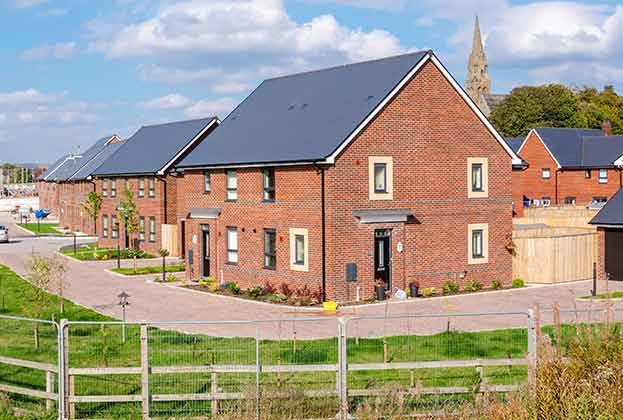Are the correct planning frameworks in place for development to appropriately respond to the climate emergency?
The Climate Change Act 2008, as well as mandating greenhouse gas reduction targets to be achieved by 2050, also established the Climate Change Committee (CCC) as an independent, statutory body to advise the UK and devolved governments on achieving those targets. Whilst the 2008 Act creates a consistent overall framework, the policy interventions that are in place vary both between and within the nations. There is little consistency in how the overarching UK target to achieve net carbon zero by 2050 is being interpreted and implemented within the nations.
This variation stems partly from the different national planning frameworks that are in place across Great Britain, and partly from national policy that includes climate mitigation goals, but does not provide a clear pathway or baseline standards to meet these goals. Across England, Scotland and Wales, there are differing legislative frameworks and targets. Scotland is legally committed to net zero by 2045, and England and Wales by 2050, but Wales has ambitions to reach this target sooner.
The existing frameworks
Where next?
The variability in approach that is evident at national level is present also at regional and local levels of Government. These lower levels of government do have an important role to play. At the end of 2020, the CCC assessed that local authorities are directly responsible for 2–5% of emissions within their area, but that they have the potential to influence around a third of all emissions within their area through policy levers, particularly planning and building control.
Given the scale of the challenge, the planning systems across Great Britain are uniquely placed to both guide the pattern of new development to the most sustainable locations as well as setting the benchmark requirements for new buildings. Of the 3 models exemplified above, we consider there are advantages in adopting a more strategic planning approach beyond a local authority level, similar to that of the existing Welsh model. The Climate Change Committee 2020 report Local Authorities and the Sixth Carbon Budget found that spatial planning is the most neglected opportunity to deliver net zero.
The Climate Change Committee 2020 report Local Authorities and the Sixth Carbon Budget found that spatial planning is the most neglected opportunity to deliver net zero
Emily Williams, Associate Director, Residential Research
The report particularly highlights energy planning as an area that would benefit from an integrated spatial approach. Scotland will be introducing Local Heat and Energy Efficiency Strategies from 2022 which establish local authority-wide plans for improving energy efficiency and decarbonising heat. This will leave England as the sole nation without a spatial energy policy. This strategic level of planning is also required to address issues such as the investment required in new transport infrastructure as well as tackling the challenge of nutrient neutrality in locations such as the Solent and the Fenlands that aren’t limited to either site or local authority boundaries.
The different national approaches referred to above, are similarly apparent in the different targets on renewable energy. The Scottish Climate Change Plan and the Scottish Energy Strategy aim to generate 50% of Scotland's overall energy consumption from renewable sources, and by 2050 to have decarbonised their energy system almost completely. In Wales, the target is 70% of electricity demand to be met from Welsh renewable electricity sources by 2030. But in England and Northern Ireland, there are no specific targets. Furthermore one of the challenges to the industry in England is the application of footnote 49 in relation to paragraph 154 of the NPPF, which requires “a proposed wind energy development involving one or more turbines should not be considered acceptable unless it is in an area identified as suitable for wind energy development in the development plan; and, following consultation, it can be demonstrated that the planning impacts identified by the affected local community have been fully addressed and the proposal has their backing.”
The effect of footnote 49 has been a dramatic reduction in applications for onshore wind: only eight onshore wind farm applications for new or extended sites were submitted in England between 2016 and 2020. In comparison, 237 applications were submitted between 2011 and 2015 – equating to a 96% decrease. This is inconsistent with the Government’s aspiration for the growth in renewables as a proportion of power generation. Revising footnote 49 to an approach closer to that in Scotland, which requires developers to work with local communities to achieve a balance between local support, environmental impact, and likely energy yield, could help renewable goals be met.
Setting priorities
There is greater scope for policy priorities to be set at a national level, ensuring that all local authorities develop policies based on the same knowledge base and best practice. For example, at present, there is no reference to the Energy Hierarchy in England’s NPPF. Paragraph 154 focuses only on the use and supply of renewable energy/low carbon energy. Paragraph 156 outlines the expectations for new development to focus on decentralised energy supply and only a brief reference at the end of this paragraph is made to minimising energy consumption. Reducing energy use and increasing efficiency should be identified as priorities at a national level to guide the emergence of local policies. Just this approach has been deployed in London, where a formal level of regional planning still exists in England, to provide just such guidance for the emerging plans of the London boroughs (see chart, below).
The planning systems will also have to grapple with the balance to be struck between the competing demands of delivering low-carbon, climate-resilient development, and meeting development needs. In respect of housing, this challenge is particularly acute in areas with low land values, especially when the need to deliver affordable housing via developer contributions is a policy requirement. There is not enough data yet to judge whether the adoption of increased environmental standards in a local plan has any impact on the level of housing delivery, but the variety of approaches currently in place risk creating a multi-tier system, where those areas with lower requirements are perceived as easier locations to develop. It is important that the national frameworks set a level playing field for the development industry and provides much-needed clarity, while leaving some flexibility to respond to specific local challenges and opportunities.
Want to find out more about Planning and Development? Read our latest insights here.
Read the articles within Planning Research 2021 below.
.jpg)


